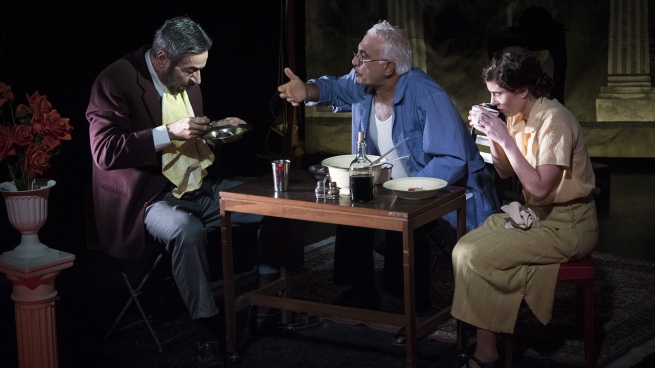The director Malena Miramontes Boim is in charge of a delicate version of “The Madonna”the piece of Mauricio Kartoun that was released almost two decades ago and that forces the springs of the grotesque Creole, with two men who wonder about the essence of women through a sinful trade.
The work returned to the ring the day before and will be on stage on Sundays in the Itaca room, in the Buenos Aires neighborhood of Almagro.
The plot is apparently simple but with obscurities: a gallery photographer (Ruben Parisi) has his dilapidated business in a loft in Parque Lezama and a hustler (Dario Serantes) sells the merchandise that the former produces among the lonely of the port area, immigrants from warm beds and others disinherited from life, which are nothing more than pornographic postcards that the portraitist makes of his own wife (Natalie Pascale).
Everything is reduced to a matter of business, the photographer defends the craftsmanship of his works with the zeal of an artist, defines the terms of his profession in the face of the simplifications of the other, and an open amorality covers everything: the action takes place in the decade of 1930 and there are vahos of those worlds narrated by Raul Gonzalez Tunon and Carlos de la Pua.
In that claustrophobia of the studio, which is also the couple’s home and dining room, the men talk about sex with implied and allusive gestures -as was the custom decades ago, when language sought subterfuge to the explicit- and Kartun takes the opportunity to develop his incomparable colloquial games made of words in disuse and with a worked rhythmic prose.
The naturalness with which the business is proposed, where the photographer’s jealousy is not reflected in the nudity and profanity of his partner’s photos but in the infidelity of a “live model” on the run, implies that he looks for a reseller substitute to continue producing his works in series.
Once the deal is done, there is a photo session -in which the director Miramontes Boim wisely omits the nudes from the 2003 version- and the hustler is entrusted to go in search of the escaped model and kill him, and the second part is transforms into a sad and drunken carnival in which the odd man seduces the woman and has a crazy adventure.
Mentioned there are groups of black drummers, perhaps undercover murderers, the docks of the port, a sad carnival with puppet shows and a lot of melancholy -González Tuñón but also Nicolás Olivari- and betrayal: the visitor and the photographer’s wife run away together, they return in disarray, and that gives rise to the fatal story of the photographer, who tells how he married his wife after rescuing her from a brothel in Rosario. Jealousy, always absent.
The universe proposed by the author has something “alchemical”, as Kartun baptizes it, even in the archaic photographic procedures that it lists, with the search for something that is not known but that is also far from the happiness of a contemporary middle class; imagination above all, even in the masturbatory ghosts that the seller treasures in his hand.
There is an essential question that the photographer asks his opponent, both intoxicated: “What is a woman?”, an intrigue that refers to mysterious and alien universes. The man inquires as if he were out of the picture, like a coffee-table philosopher looking through glass. Kartun’s theatrical language is at its peak.
The director manages to get Parisi and Serantes to handle their characters cunningly, almost inhuman, almost carnival dolls in their movements, with an old-fashioned Buenos Aires intonation that refers to radio theater or old movies, and contrasts in them the rejection of the spectator with the pity, meanness with the pious, disgust with the ridiculous.
Natalia Pascale, the center of the matter, is the one who is least on stage, however; she is La Madonnita, as she is called by her feverish admirers, for more information she is mute: her body work defines her creature with a certain deformity with enormous skill and she has a powerful weapon in her gaze ; all her sadness and perhaps her imminent rebellion resides in her.
There is a suitable scene Michaela Sleighwhich uses a backdrop and props provided by the Simik Photographic Museum Palace Bar, in the Chacarita neighborhood, appropriately bathed in the lights of Javier Vazquezand the sound design of Matthias De Stefano Barbero it is very timely.
“La Madonnita” also has costumes for Cecilia Gomez Garciastage design assistance Guadalupe Borrajofrom photographs of Florence Laval and address of Vanina Little Horse and is offered on Sundays at 7:30 p.m. in the room located at Humahuaca 4027.









